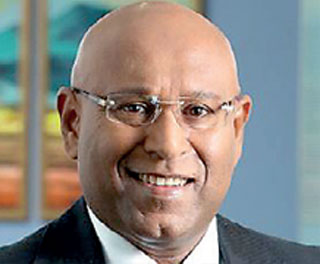Monday Jan 05, 2026
Monday Jan 05, 2026
Wednesday, 23 February 2022 05:03 - - {{hitsCtrl.values.hits}}
 |
| Chairman Eshana De Silva |
 |
| Director and CEO Dimantha Seneviratne
|
National Development Bank PLC, fourth largest listed bank and most awarded corporate, said yesterday it posted sound all-round performance for 2021 and sustained growth in several financial KPIs, notwithstanding the multiple challenges that marked the year.
Director/CEO Dimantha Seneviratne said that the retrospect of 2021 had many reasons to be grateful for. “We managed one of the largest equity infusions in the history of the bank netting Rs. 9.5 billion and onboarded the Norwegian Investment Fund for developing countries (Norfund) as our top shareholder with a 9.99% ownership.
Our strategy remained well on track with strong delivery across all areas and we extended support to our pandemic-hit customers via a host of modes.
“The sustainable growth trend we have maintained over the years continued, with the bank achieving triple Rs. 500 billion in total assets, gross loans and customer deposits. I am proud of the NDB Team, whose perseverance and relentlessness made another good year possible, whilst as a bank, we are deeply grateful for the unstinted loyalty and confidence of our investors and customers,” he said.
Analysis of financial performance: Income and profitability
Core income sources of the bank enhanced during the year compared to 2020, attributable to the timely delivery of the bank’s strategy milestones. Net interest income enhanced by 22% to Rs. 21.6 billion, despite a marginal decline in interest income, which was off-set by a larger decline in interest expenses.
Net interest margin recorded a notable improvement to 3.25% from 3.07% in 2020. Net fee and commission income also enhanced by 32% to Rs. 5.6 billion. Exports related trade services was a key contributor in this aspect, with digital financial services and other asset products also contributing. Other non-fund-based income on an amalgamated basis increased by 11% to Rs. 3.8 billion.
The bank saw a considerable increase in its impairment charges for the year of Rs. 10.3 billion, up by 51% compared to similar charges in 2020. The bank consciously reviewed the stress levels of the customers on a prudent basis in lights of the prevailing economic conditions and accounted for impairment charges on an individually significant basis as well as on a collective portfolio level basis, using objective evidence of customer credit quality.
Resultantly the Impaired Loans (Stage 3) Ratio and Impairment (Stage 3) to Stage 3 loans Ratio both increased, to 4.55% (2020: 4.47%) and 32.81% (2020: 31.68%) respectively. With regards to impairment provisions on foreign currency denominated government instruments, the bank increased such provisions up to Rs. 2 billion, factoring in the revisions of the sovereign rating of the country.
During 2021, the bank continued its strong focus on cost management through process streamlining via the application of Robotic Process Automations, converging transactions to sustainable and less-costly digital modes, resource conservation, etc.
These augured well for the bank with total operating costs curtailed at Rs. 10.4 billion (YoY increase of 11%) amidst hiking inflation seen during the latter part of the year. Cost to income ratio, preserved the consistent trend of improvements and closed at 33.7%, notably lower than that of 2020 which was at 37.0%.
The resultant operating profit before taxes was Rs. 10.3 billion an increase of 12%. Total taxes for the period were Rs. 3.9 billion with an effective tax rate of 38%. Accordingly, post-tax profitability reached Rs. 6.4 billion at a YoY growth of 15%, whilst profits attributable to shareholders of the bank reached Rs. 6.9 billion, with an YoY growth of 35%.
Balance sheet performance
Business growth retained momentum through concerted efforts in balancing the dual aspects of caution and support to the needy segments of the economy. Accordingly, total assets grew at 12% over 2020 and reached Rs. 703 billion, demonstrating promising potential in reaching the Rs. 1 trillion target by 2025, aspired under the bank’s long-term strategy.
During the year, gross loans grew by 19% to cross the Rs. 500 billion mark to Rs. 526 billion, a quantum of Rs. 82.6 billion, and a diversified growth stemming from all business segments. Loan book quality denoted by the Non-performing loan (NPL) ratio broadly improved, with the ratio improving to 4.65% from 5.35% in 2020. Net NPL ratio was 2.29% (2020: 3.23%).
With regards to funding sources, customer deposits also crossed the Rs. 500 billion mark to reach Rs. 552 billion, enabled by a YoY growth rate of 13% - an equivalent of Rs. 62 billion. Deposits composition largely enhanced, wherein the CASA composition was 27% compared to 25% of 2020. CASA base grew by an impressive 22% - equivalent of Rs. 27 billion and to close at Rs. 150 billion.
As previously mentioned, funding improved with the equity infusion of Rs. 9.5 billion, made up by a fully subscribed Rights Issue of netting Rs. 8 billion and a Private Placement by Norfund – The Norwegian Investment Fund for developing countries netting Rs. 1.5 billion. The bank also raised Rs. 8 billion in Tier II capital in November 2021 by way of listed debentures, with the Issue oversubscribing on the Issue open day in the Colombo Stock Exchange.
Investor and regulatory ratios
Return on average equity and Earnings per share were 12.27% and Rs. 20.68 respectively, marginally lower than those of 2020 (13.13% and Rs. 23.77 respectively). The increase in profitability was off-set by the increase in the capital base enhancement from the equity infusion. Pre-tax Return on Average Assets broadly stabilised at 1.55%.
Regulatory ratios of Liquidity Coverage Ratio (Rupee), Liquidity Coverage Ratio (All Currency) and Net stable Funding Ratio all improved compared to 2020 and also stood above the regulatory minimum requirement of 100% at 193%, 171% and 118% respectively. Enhanced capital positions were denoted by Tier I and Total Capital Adequacy ratios of 10.01% and 15.42%, ahead of the regulatory minimum levels of 8.00% and 12.00% respectively.
Net asset value per share as at end 2021 was Rs. 165.02 (2020: Rs. 192.49), the reduction of which compared to 2020 – despite an enhanced Net Assets base is attributable to the increase in the number of shares post the equity capital infusion in May 2021.
An equitable performance across all aspects
NDB continued to demonstrate its dynamism and versatility through a balanced performance in addition to financial performance. The bank conducted scores of initiatives ensuring the wellbeing of its staff, customers and the community in response to the COVID-19 pandemic, under the structured program ‘NDB Cares’.
From a strategic perspective empowering the SMEs and export oriented business took centre stage, aligning the bank’s priorities to those of the national economic growth agenda. NDB Jayagamu Sri Lanka completed a successful year since its launch in 2020 driving this stance. Support to the women’s market segment also strengthened during the year, under NDB Araliya – NDB’s financial and advisory support proposition, as well as through Sri Lanka Vanithabhimana – the national level recognition program for high performing women.
The bank’s digital drive accelerated with a number of industry-first launches. The bank also strengthened its ESG practices including commitment to a greener planet, through a number of flagship events. Such excelling performance was externally endorsed by multiple local and international bodies with over 70 awards and accolades.
Prospects
NDB has reached a pivotal juncture in its growth journey. Its strong capital position has enabled it to pursue ambitious growth targets. The bank’s capital market subsidiaries are expected to further enhance synergies amidst the improvements seen in the Sri Lankan capital markets.
With a robust strategy guiding the bank with strong focus on digitisation, NDB is set to explore unchartered courses in bringing novel experiences to its customers. NDB will continue its service to the nation as a responsible financier, through close congruence with the national development agenda and by attuning its actions in responses to emerging economic challenges.